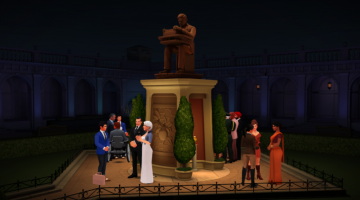
During last month’s Game Developer Conference, longtime coder and designer Chris Hecker invited me to a game demo event with a tidy premise. “We are going to talk about three things,” he said as he began booting a six-year-old ThinkPad. I immediately laughed in response.
Hecker invited me under the pretenses of unveiling news about his long-in-development one-on-one video game SpyParty—one I have followed for years, owing to its tense and truly unique face-offs. Every three-minute match pits one “spy,” who acts like an AI character at a video game party, against a sniper, who watches the entire party play out before guessing who the human is among the computer-controlled crowd.
Sure enough, Hecker had specific news to share: an April 12 launch date for the game on Steam Early Access, a new slew of game features, and a $25 price. (Discount hunters have ten days to buy the game at its beta-test price of $15, which will include a Steam key.) As I laughingly assumed, it took us a while to get to that trio of facts. First, we had to shovel through more than eight years of SpyParty development rubble, which has cost Hecker hundreds of thousands of dollars in the process.
-
Welcome to SpyParty! You will likely die stupidly at first, which Chris Hecker anticipates…
-
…so the game is thus shipping a beefy replay view mode, complete with split-screen views and easy timestamp jumps at every significant moment. Look to the article for more on how this two-player game pits a spy (left) against a sniper (right).
-
If you’re the “spy,” your objective is to complete a certain number of tasks before time runs out. Simply faking like an AI character for a three-minute match won’t cut it. If you’re the “sniper,” you have to watch a party carefully and guess which character is the human-controlled spy, not the other computer-controlled partygoers. Seeing anyone appear to complete these listed tasks is a pretty good tell.
-
Hecker has also built and narrated a gargantuan, hour-long tutorial. You can hop into the game after the opening 5-minute explainer completes, but the rest of the tutorial breaks down the advanced theories and strategies that players will inevitably face.
-
The number of party attendees will vary based on the map chosen.
Good, hard game-design problems sometimes take what I call wall-clock time to solve,” Hecker says while hunched over his ThinkPad. In the case of SpyParty, that tally has climbed to nearly eight years, through which time Hecker has paid an artist, his former Maxis colleague John Cimino, for 5.5 years of work as its art director. Other than a one-year contract hire for additional art, that’s it. Hecker has otherwise run the entire show by himself—as director, lead programmer, game designer, network coder, animation designer, sound designer, UI lead, and even PR lackey.
That amount of time—to iron out, fine-tune, and perhaps even hoist the game with his own petard—has come at a significant cost. When pressed, Hecker breathlessly chronicles his financial books in a way you rarely hear in the game-publishing world. “A few hundred thousand dollars” saved during his 1990s days as a Microsoft engineer: “That’s all gone.” Another hundreds-of-thousands in savings from his five years working at EA and Maxis on the character generation system in the uneven Spore (possibly the game’s best feature): “That’s all gone.” He then confirms the near-exact beta sales figures so far for SpyParty, sold through a credit-card acceptance system he coded by hand: 24,000 copies for $15 each. “That’s all gone.”
He laughs while confirming other intangibles: He has borrowed from his mother, and he tells me the exact low figure he pays for his mortgage in the Bay Area. (“My ex-wife is a real estate genius,” he says.) After saying he “refuses” to count the exact figure, he then immediately estimates an eight-year burn between $600,000 and $1 million.
I can go for a while,” he adds, “but now, hey, it’s time to go on Steam Early Access. I could borrow more money from friends. I used to work at Microsoft. I have a lot of rich friends who’d loan me money. But I really like Early Access.”
After hearing him talk so deeply about the game’s design, it’s easy to believe him when he says that the game’s April 12 Steam Early Access launch is more about making a better, stronger 1v1 experience than about cashing out. He offers a thoughtful explanation of what does and doesn’t work on Early Access. “Sports” and “procedurally generated” games are a better proposition for making shared games better by letting interested players bang their in-progress systems out. He also points out genres that he doesn’t like as much on Steam Early Access, including firmer narrative and puzzle experiences. And while SpyParty has been available to purchase from his own site for a few years, he knows Steam Early Access will widen the net, and he acknowledges that some gamers don’t want to submit credit card information through his own specific payment interface.
But the version Hecker has been selling has, up until now, been better described as Too-Early Access. Its wholly functional online modes have been pockmarked with simple arenas, an ancient matchmaking system, and other missing features. The game’s latest update, which Hecker says will go live Monday, counts as a significant, Steam-worthy milestone, complete with a new, lengthy tutorial and the first complete roll-out of Cimino’s art-design ecosystem.
-
SpyParty‘s full map reveal is striking for two reasons. First, because it exposes interesting level design stuff (read the interview for more context), and second…
-
…because up until this week, the game has revolved around older graybox shell designs. It’s really a whole new experience from a perspective and eye-direction level now.
-
Here’s a peek at the 10 arenas shipping in the Steam Early Access version. In this room, frames and perspective block the otherwise open view, as the sniper must spin around this level in 360 degrees.
-
The same 360-degree spin is required for snipers here, but a giant statue (of Alan Turing, natch) changes strategy for both sides.Chris Hecker
-
A closer zoom at this Courtyard arena, to reveal detailed art on the Turing statue mount and the detailed characters. Studying their animations is absolutely key to winning as a sniper.
-
Snipers swivel around the exterior semicircle in search of spy activity.
-
The sniper can focus attention through a single window here, but must deal with specific object and character obfuscation.
-
Some minor blockage and a reduced amount of swivel.
-
Snipers sit in the middle and can rotate like a turret to keep tabs on the whole scene.
-
Another look at the Library arena. Those statues may very well play into one of the spy’s missions, and thus, this shot of four possible characters lurking near them can look quite stressful for a sniper player.
-
A little more complicated from a view and angle perspective.
-
This open corner includes a peek into one crucial interior scene.
-
The level defaults to this open-yet-limited party space…
-
…but Hecker laughingly hinted to designs on a larger “many snipers, many spies” mode that would expand across this larger field of geometry.
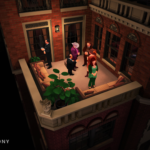
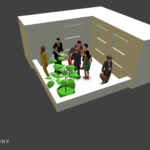
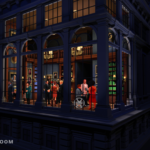
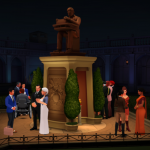
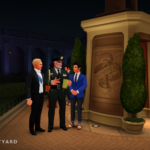
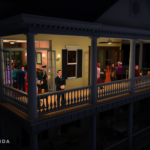
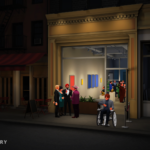
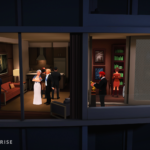
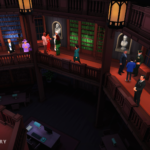
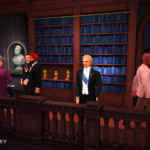
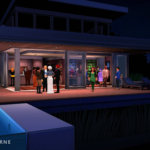
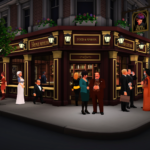
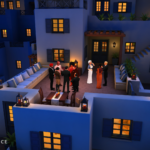
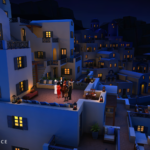 The above gallery shows off the game’s full suite of one-on-one arenas; up to ten are included in the Early Access version. They’re all built out with thoughtful architecture, lighting, and color touches. (Hecker admits that a lot of the lighting effects are baked in or rely on simple tricks, then gestures to his six-year-old ThinkPad. “An ancient laptop keeps you honest as a programmer,” he says.) They’re all attractive in a clear-yet-smoky, “James Bond meets The Sims” style. Hecker loses himself while gushing over each level, particularly when he describes Easter eggs packed into the level with a prominent Alan Turing statue.
The above gallery shows off the game’s full suite of one-on-one arenas; up to ten are included in the Early Access version. They’re all built out with thoughtful architecture, lighting, and color touches. (Hecker admits that a lot of the lighting effects are baked in or rely on simple tricks, then gestures to his six-year-old ThinkPad. “An ancient laptop keeps you honest as a programmer,” he says.) They’re all attractive in a clear-yet-smoky, “James Bond meets The Sims” style. Hecker loses himself while gushing over each level, particularly when he describes Easter eggs packed into the level with a prominent Alan Turing statue.
Most of Hecker’s gushing is about the gameplay possibilities packed into each map—which makes sense, given that SpyParty works as a thoughtful game, not a bombastic one. His new build’s screenshots only do so much to sell the slow-building drama inherent in a typical SpyPartymatch, after all.
Take the Courtyard arena with the Turing statue as an example. The spy and the sniper constantly do a dance during the course of a three-minute match, Hecker points out, and one factor is that the sniper’s view is always represented by a thin-but-visible laser scope, which the spy can see. Thus, the Courtyard’s view-blocking statue is absolutely a benefit for the spy, because the spy will sometimes need to complete tasks (swap a statue, slip a tracking bug onto another partygoer, whisper something to a guest) and will appreciate the cover. But what if the sniper expects that—and uses SpyParty‘s interface to mark party guests who seem to conveniently walk behind the statue on a regular basis as “suspicious”?
Hecker is obsessed with the competitive-gaming concept of “yomi,” a shorthand phrase for reading and anticipating an opponent’s next move. If you made a drinking game out of whenever Hecker said the word “yomi,” you might die of alcohol poisoning during a short conversation. That obsession spills over into SpyParty, because Hecker overloads the game with tools you can use to understand how the game works and read into your opponent’s actions. A substantial replay system, which auto-saves all of your online matches, lets you review split-screen perspectives of how your matches played out and where your opponent’s attention turned at every millisecond of the game.
Even crazier is the game’s “dossier” section, which lets you review every single animation of the game’s 21 characters. Hecker loads the animations that play out when certain characters place a bug during a match. He focuses on an old, African-American character walking with a cane.
“There, he’s going to do it,” Hecker says, live-narrating this dossier interface’s animations. The cane-holding arm raises ever so slightly (as you can see in the above GIF-filled gallery), but it’s definitely a break in his normal walking animation.
“Whoop, there he went.” Hecker locks eyes with me, gesturing as emphatically as he’s done our entire conversation. “Now you see, this guy’s left-side, cane-side walking bug is really subtle. It barely moves, just a little ‘whoop.’ He’s a very powerful character on that side. Which makes him suspicious, which means you don’t want to pick him [as your character]. Which means you dowant to pick him, because of the yomi craziness.”
Table of Contents
Toggle“I vowed to make the opposite mistake”
This cane-rattling moment, and the thought of the SpyParty gameplay that follows—not just in a single, tense versus match, but in the number of hours required to understand the game’s “staring at computer characters” systems to such a granular level—made something click for me. Hecker has listed off big numbers and large amounts of time, but after hearing him explain how deeply this goes, I begin to appreciate how crazy this game has made him.
Part of the overlong development cycle, he admits, comes from a GDC Austin talk given by longtime Blizzard designer Rob Pardo while Hecker was still working with Maxis on Spore. The talk’s primary takeaway was “depth first, accessibility later”—that a game isn’t worth a great tutorial or easy-to-play opening sections if there isn’t something worth getting hooked onto for hundreds of hours.
“I was nervous because we did a lot of accessibility work on Spore but didn’t work on that depth thing as much,” Hecker says. He’s careful to point out the depth of some of Spore‘s technical and gameplay systems and how much he learned with his team. “There’s more magic in Spore than in most games, but it never cohered in my opinion as a deep game design. It didn’t hang together.”
For his next game, then, “I vowed to make the opposite mistake.”
“My therapist could probably make an indie game in her spare time, developing on Unity or something like that.”That intensity hasn’t waned over eight years, and Hecker blames that in part on the popularity of Dota 2. “When that came out, I realized there was no such thing as ‘too complicated’ [in a game],” he says. He takes this opportunity to describe a feature he wants to add to SpyParty: a “traits” system, which has each AI-controlled character act in certain ways by default. Meaning, any spy player who controls the woman in the green dress and doesn’t pay attention to her proclivity to, say, accept drinks or avoid polite conversations will look suspicious to a savvier sniper player.
This, of course, is coming from the guy who pulls out a notebook during our interview to catalog and diagnose a game-crashing bug. Minutes after writing that reminder, he remarks on how the game’s updated online-matchmaking system currently doesn’t work. He nervously laughs as he names the exact number of days left before the Steam Early Access launch.
Unlike our 2012 chat, at least, Hecker is in a calmer place in spite of his current panicked, bug-squashing status. He’s willing to endure a rough launch period and the inevitable bugs it will surface. He seems to have truly let go of the pushback he received after lambasting the low-powered Nintendo Wii in 2007—and again after critics assigned Spore-related blame to him one year later. Hecker, after all, has no shame rattling off stories about his own life. He even talks at length about his therapist, who he believes could “make an indie game in her spare time, developing on Unity or something like that,” based on how much he’s told her about the development of SpyParty.
But he declines to similarly to dwell on those late-’00s stories. “I’ve been working on SpyParty for almost a decade. Let’s talk about SpyParty. I’ve been so head-down on this. It’s not like I’m famous among non-game developers.”
He has also made a bizarre peace with the idea that SpyParty could just one day stop running: “if I got hit by a bus the day it went up on Steam Early Access, it’s a good game,” he points out, and he clarifies that he means that both from a “bang for the buck” perspective and from an “intriguing psychological game” perspective. He also is constantly careful not to assume any success is on his way—that 24,000 buyers at SpyParty.com may never be matched by that many buyers on Steam. He’s immensely grateful for his game’s community, blaming much of the game’s success thus far on them. “My community is the best in the world right now,” he says. “If you went online with no games played, someone with 5,000 games would come up to you and tell you, ‘hey, want me to teach you how to play?’ That just doesn’t happen in competitive multiplayer games, for the most part.”
Hecker’s relationship with SpyParty might best be described as happy and near-zen. It could go away—poof—and he’d open source its content and server architecture, he says. “If it flopped and I immediately had to go get a job at Facebook, I can program,” Hecker says. “I’m not going to starve to death.” He’s already proud of what’s out there and the dedicated players who’ve gotten hooked on its study-people’s-psychology systems.
Or it could keep going. Hecker may be in a peaceful mental place, but he clearly doesn’t want his SpyParty to end just yet.
“Some people would say, ‘I’ve been working on a thing for three years, and now I have to go do something else that’s interesting.’ I don’t do that, obviously”—he says while once more gesturing at his ThinkPad. “For me, nobody makes games about normal people in a room. There’s game design lying all over a room. You just have to go and pick it up. In SpyParty, there are games within games within games. Lots of the things that I want to explore as a game designer in my career, I can do inside this game. It’s a sponge for game design.”
Listing image by Chris Hecker
-







